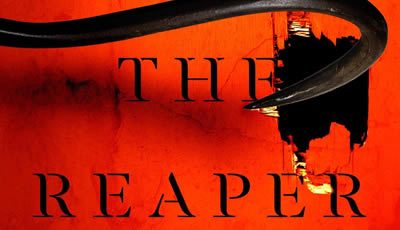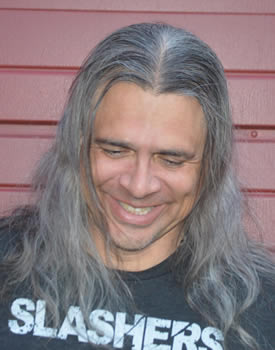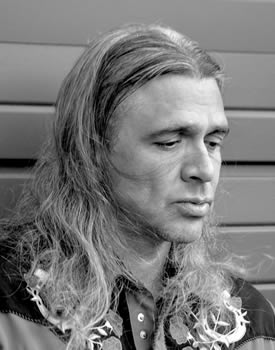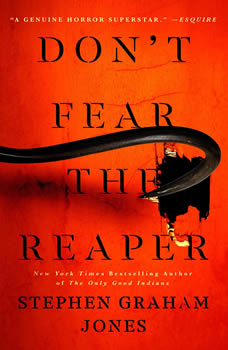

Between The Lines Between the Lines: Stephen Graham Jones
Fear the Reaper a Lot, Actually
[Ed. Note: The following feature contains mild spoilers for the first installment of the Indian Lake trilogy, My Heart Is a Chainsaw.]
Anyone who delves into Stephen Graham Jones’s latest release, DON’T FEAR THE REAPER, might be surprised to learn it was never supposed to exist. In the first draft of the book’s predecessor, 2021’s Stoker Award-winning My Heart Is a Chainsaw, Jones didn’t leave anyone alive to carry on the grim tale of Proofrock, Idaho, a town plagued by a centuries-long history of murder and misfortune.
Thankfully, though, an editor asked Jones to consider sparing a few of Proofrock’s more distinguished residents, including fan-favorite heroine Jade Daniels, whose encyclopedic knowledge of horror movies prepared her for the bloody ordeal that descended on her hometown, and tech heiress Letha Mondragon, whom Jade recruited to serve as the final girl who might save Proofrock. DON’T FEAR THE REAPER picks up four years after Chainsaw, with Jade just released from prison and Letha still recovering from the grievous injuries she suffered during what’s now known all over the country as the Independence Day Massacre.
But Proofrock isn’t done with slashers—or maybe it’s the other way around. Before the action of REAPER begins in earnest, a hulking, near-mythic killer named Dark Mill South has already slashed, stabbed, strangled, and electrocuted his way through a large swath of the American West. His origins are uncertain, but he’s thought to be of Native American descent, and some think his horrific murder spree is vengeance for the mass execution of 38 Dakota men in 1862. Whatever his motive, Dark Mill South is an engine that runs on blood, pain, and fear, so he was probably always destined to make his way to Proofrock—where Jade and Letha are waiting.
In the weeks leading up to the much-anticipated release of DON’T FEAR THE REAPER, Jones joined The Big Thrill to talk about slashers, the evolution of his epic trilogy, and his impressive career.
DON’T FEAR THE REAPER essentially begins with an entire slasher franchise boiled down to just a few pages. Is that how you thought of Dark Mill South’s backstory and his character?
No, what I needed was a killer who is extremely capable. In any story, you have to have the antagonist be more capable than the protagonist so that when the protagonist wins, it’s a big feat, they’ve overcome all that stuff. I had to give him this big, bad history—he’s just a tough dude. He is really committed to the enterprise. I had to build him like that, and it was really fun to drop into that kind of fake scholarly voice to deliver his history, his biography, all that.
But where did he come from? In the acknowledgements, you mention that his name was a misunderstanding of the lyrics of Jerry Reed’s “Amos Moses”—you heard “Doc Milsap” as “Dark Mill South,” and here we are. But he’s so fully formed, and he’s almost mythic. He doesn’t seem like a guy who just popped up out of nowhere for this book. Or maybe he did?
He sort of did. He wasn’t meant to make it as far as he does in the book. The way I initially conceived him, he was gonna be this big bad killer who comes to town, and then within a matter of minutes, he gets put down. But then I built him too bad. He couldn’t be put down easily.
Speaking of the acknowledgments, you talked about The Two Towers and The Empire Strikes Back as stories that guided you through this middle installment. How did those stories help you find your way?
 What I got from them was tone. Especially at the end of The Empire Strikes Back—Luke has lost his hand, Han is in carbonite. The Empire is really pressing down on these rebels, and how are they ever gonna live? They have a big victory, but we know it’s just a battle; it’s not the war. And that’s also what I got from The Two Towers—the trees and the hobbits win the battle, but they haven’t won the bigger war. That’s what I got from those two: that you need to give your characters what feels like a victory with the understanding that there’s more fighting to come.
What I got from them was tone. Especially at the end of The Empire Strikes Back—Luke has lost his hand, Han is in carbonite. The Empire is really pressing down on these rebels, and how are they ever gonna live? They have a big victory, but we know it’s just a battle; it’s not the war. And that’s also what I got from The Two Towers—the trees and the hobbits win the battle, but they haven’t won the bigger war. That’s what I got from those two: that you need to give your characters what feels like a victory with the understanding that there’s more fighting to come.
Are there times when you’ve found it difficult to translate the slasher from cinematic terms to literary ones?
It’s totally tough. The slasher grew up at the box office, so many of its techniques, its shorthand, its tricks are visual in the sense that they come from cinema. Jump scares, number one, are baked into the slasher, but it’s really tricky to do a jump scare on the page. In The Only Good Indians, I knew I wanted to do slasher-cam, where we’re looking through the eyeholes in the mask, basically. So I had to figure out a way to do that. And with My Heart Is a Chainsaw and DON’T FEAR THE REAPER, I did want to—I don’t know about maintain, but at least suggest the cinematic DNA of the slasher, so I went with present tense, because film feels more present tense to me than fiction. Present tense seems to be film’s default setting, if that makes sense.
It does—when you watch a film, you’re usually experiencing events as the characters experience them, so present tense feels like the literary equivalent. Okay, so there are slasher film conventions you wanted to keep, but one thing that’s really striking about this series is that there are no faceless victims, right? Especially in DON’T FEAR THE REAPER, you feel every death, even if a character’s only purpose in the plot is to feed the beast, so to speak. But that’s not always the case in slasher movies, right? Do you ever view the series as corrective in that sense?
The slasher thinks bodies are very disposable. And in particular, it thinks that women’s bodies are super disposable. I’ve always been uncomfortable with that. And so, in My Heart Is a Chainsaw, I tried to work up to the point where each death mattered. The trick is, you have to do a blood sacrifice, but you’ve also got to say, These people matter. That has definitely been a big part of my project. Hopefully, by the time we get to the third book, it’ll be more starkly realized. But yes, I don’t like the way the slasher disposes of people.
You can love something, and not love everything about it, right?
I think that’s what Scream did in 1996. It put the slasher on a pedestal, but it didn’t say, that thing’s perfect. It made fun of the parts that needed making fun of so it could carve them off and leave the genre leaner and meaner and tougher.
You’ve also driven home the point that the slasher is often motivated by revenge for a wrong that was never punished. To what extent are final girls and slashers cut from the same cloth?
Yeah, I kind of wonder about that. If it’s a coin, it’s screaming on one side and laughing on the other, and it just flips through the air for the whole narrative. And in the same way, I wonder if the final girl and the slasher are also two sides of a smaller coin? Because they do seem to have the same heart a little bit. And I think a final girl, in her final transformation when she finally overcomes the slasher—it’s almost like she has caught the monstrousness that she’s fighting.
She has to almost become it.
Yeah, she does. And I think that’s always a Pyrrhic victory. It’s not a pure victory anymore if you have to trade in some of your identity. Which is why Nancy in A Nightmare on Elm Street, she’s one of the very few final girls who holds on to her identity. She thinks her way out of it. Instead of having to reduce herself to Freddy’s tactics, she uses her brain, and she gets the book on booby traps, and she turns her back on Freddy. I think she’s one of the premier final girls because she stays herself.
So I’m assuming that when you wrote My Heart Is a Chainsaw, you knew it would be a trilogy from the beginning?
 No, I had no idea. I wrote the first one and sold it to Saga. [Saga Editorial Director] Joe Monti was working on revisions with me, and he had me change the title and change a lot of little things. And then we got to the end, and he said, What if you didn’t kill everybody? And I said, No, you don’t understand. I’ve been writing this book for a long time. I know these characters. And he said, Well, the reader has invested X number of hours to read this and get to the end, and everyone they believe in dies gruesomely. He said he didn’t think people were going to be happy. He didn’t make me change it, but he told me that maybe I should just consider looking at it from the other way. And I respect him. He’s a really smart guy and a good editor. So I opened up a side document and said, Let’s see what it looks like if not everybody dies.
No, I had no idea. I wrote the first one and sold it to Saga. [Saga Editorial Director] Joe Monti was working on revisions with me, and he had me change the title and change a lot of little things. And then we got to the end, and he said, What if you didn’t kill everybody? And I said, No, you don’t understand. I’ve been writing this book for a long time. I know these characters. And he said, Well, the reader has invested X number of hours to read this and get to the end, and everyone they believe in dies gruesomely. He said he didn’t think people were going to be happy. He didn’t make me change it, but he told me that maybe I should just consider looking at it from the other way. And I respect him. He’s a really smart guy and a good editor. So I opened up a side document and said, Let’s see what it looks like if not everybody dies.
Sure enough, he was right. And then when I still had a few people propped up at the end, bleeding but alive, I realized this needs to open up into a trilogy, because I think slashers come in trilogies, kind of. Even the long franchises seem to work in arcs of three. And also, that’s my favorite kind of horror sequel, or slasher sequel in particular—like with Friday the 13th, where the first was never planned to franchise out. But it’s such a success that the market and the studio demand that there be a sequel, and so they bring in a different team who tries to plunder the vestiges, the ruins of the first story for any scrap of thing that they can use to open it up again. And that effort of just feeling through the ashes for one little speck or thread that we can extend into a franchise—I love, love, love that effort. And so I wanted My Heart Is a Chainsaw to feel like it was never supposed to branch out. But then here comes DON’T FEAR THE REAPER, and that means somebody found more stories.
I’m curious about how the slasher translates across cultural lines. Have you found that the slasher looks different if you view it through different lenses?
I think it does a little bit. Like, if the slasher is a justice fantasy, then if you’re delivering a story to a people, a culture, who are in dire need of a justice fantasy because they feel like the world has done them wrong—I think they will still watch it for the roller coaster of screams and gore gags, but I feel like we can extract a different sense of truth from it, if that makes sense, in that when we see the final girl overcome, that is us. That is each of us resisting our bullies. But for American Indians, our bully has been the settlers of America, Europe, coming across the ocean. And so it’s almost like this whole wave of people started coming across in the 15th century—that is our bully. And yes, we can we knock it down. It keeps getting back up, but we’ve got to keep trying to knock it down. And we also have to insist on our own lives and keep living and living, because sometimes it’s not actually about fighting. It’s about lasting longer.
I like that term. You use it in the books, when the characters “insist” on their lives.
It’s different than asking for your life. Asking for your life is giving someone else power. Insisting on your life is saying I’ve got it whether you’re going to give it to me or not.
I love it. So I know that you write in pretty much every spare moment that you have, right? I’ve often wondered how rewrites and revisions fit into that schedule. How close do you tend to get on your first drafts?
I rarely ever get it right the first time. I think the only times that’s happened are The Last Final Girl, The Long Trial of Nolan Dugatti, and It Came from Del Rio—I think those are the only three that have needed hardly any revision. Either I lucked into it, or whoever was my boss at the time didn’t care. [Laughs.] My Heart Is a Chainsaw went through some major, major revisions. DON’T FEAR THE REAPER got to keep its title—most of them get changed for the better. But [the manuscript] did change a lot. In the initial draft that I gave to the editor, to Joe Monti, Dark Mill South looked the same, but his insides are not the same. He didn’t have an arc, and that’s what Joe told me. He said, This dude is scary, but he has no development, he has no depth; he might as well be a bear or something.
And he was totally right. So I had to go back and figure out what Dark Mill South’s story was, and then put it on the page in such a way that the explanation didn’t kill the horror, because that’s the thing you’re always dancing with in horror: Explanations do not make things scarier. So it kind of ended up being such that I had to completely know his backstory, and then only deliver like 15 percent of it on the page—enough to give the reader a sense that he’s coming from a place that’s real, even if they can’t 100 percent articulate or identify that source. It was really helpful when Joe told me that—to me, that’s the moment at which the story became real. I’m lucky to be working with people who will tell me these things.
Going back a bit, The Only Good Indians is often called your breakout novel. Did it feel that way to you?
It’s probably been the one that’s gone the farthest and moved the most. But to tell you the truth, it feels to me like Mongrels was that for me. My first novel came out in 2000, and I think by 2006, I had four or five novels and one collection. And what I found going to those early book events—conferences, conventions, bookstores, book groups, universities, all that—the questions I kept getting about these novels weren’t stopping at the novels. They weren’t limited to the story, the characters, the world. They were instead using the book as a lens to look at American Indian culture, which is kind of what happened in the literature classroom. I understand the impulse. But at the same time, I think it’s really dismissive of the story, the novel, the book. And it’s not just me—it happens across the board to a lot of different people. And I thought, Well, this sucks. How can I make this stop? And the best way to make it stop was to write stuff that the people who were asking the questions wouldn’t be able to access. So I went to slashers, zombies, vampires. I started writing all that, which has always been closest to my heart anyways. And I’ve been writing it from the get-go, but I started publishing novels on it, and I was kind of daring that crowd to find these same cultural issues. I was trying to make them stop at the book, if that makes sense.
But the problem was, I still had the impulse to do these weird experimental literary novels. Like a second-person, small-town noir [2014’s Not for Nothing], or a novel about a kid working the window of his father’s drive-thru urinal [2013’s Flushboy], and just weirder and weirder stuff—a time-travel novel that uses a moose as a time-travel device [2008’s Ledfeather]. And so, right around ’04, ’05, ’06, I feel like I became two writers on parallel tracks. One was doing commercial/genre stuff, and the other was doing literary/experimental stuff. It was splitting my readership, but I don’t really worry about stuff like that; I just write the best book I can. But it was dividing me. I felt like I was two people, and I maintained that for about 10 years. But then finally with Mongrels, I figured out a way to write about the horror creatures I love—werewolves, in this case—but do it with an experimental delivery system: these flash fictions mixed in with stories as chapters. I feel like with the publication of Mongrels, I didn’t even mean to, but I luckily became one writer again, working on a single track. And once I became one writer again, then I was off to the races with Mapping the Interior and then The Only Good Indians, My Heart Is a Chainsaw, Night of the Mannequins, and so on. So I feel like Mongrels is the one. Maybe it wasn’t a breakthrough success … but it was my on-ramp. It was the book in which I gelled into a single writer again.
Can you tell us anything at all about your upcoming novel I Was a Teenager Slasher?
It’s set in Texas, where I grew up, in 1989, and there’s a lot of farming, a lot of small town, a lot of tractors and trucks, but a whole lot of dead people too, dying in terrible, terrible ways. The same way I had messed around with the slasher in The Only Good Indians and The Last Final Girl and My Heart Is a Chainsaw and DON’T FEAR THE REAPER—I wanted to find another way to do a slasher that we haven’t seen yet. I haven’t read everything, so it could be that somebody’s done this. But if anybody’s done what I’ve done in I Was a Teenage Slasher, then I haven’t read it, anyway.
And finally, can you tell us anything about the third installment of the Indian Lake trilogy?
I can tell you we’re not announcing the title yet. We did land on the title about three weeks ago, which I’m pretty excited about. I finished it in August, and it’ll be out eventually, I’m guessing in 2024. Jade’s story does come to a close, for better or for worse.
- AudioFile Spotlight: March Mystery and Suspense Audiobooks - March 17, 2025
- Africa Scene: Shadow City by Natalie Conyer - March 17, 2025
- The Ballad of the Great Value Boys by Ken Harris - February 15, 2025

